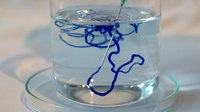
Photo from wikipedia
The mechanical properties of biomaterials are dictated by the interactions and conformations of their building blocks, typically proteins. Although the macroscopic behaviour of biomaterials is widely studied, our understanding of… Click to show full abstract
The mechanical properties of biomaterials are dictated by the interactions and conformations of their building blocks, typically proteins. Although the macroscopic behaviour of biomaterials is widely studied, our understanding of the underlying molecular properties is generally limited. Among the non-invasive and label-free methods to investigate molecular structures, infrared spectroscopy is one of the most commonly used tools, because the absorption bands of the amide groups strongly depend on protein secondary structure. However, spectral congestion usually complicates the analysis of the amide spectrum. Here, we apply polarized two-dimensional (2D) infrared spectroscopy (IR) to directly identify the protein secondary structures in native silk filks cast from Bombyx mori silk feedstock. Without any additional analysis, such as peak fitting, we find that the initial effect of hydration is an increase of the random-coil content at the expense of the α-helix content, while the β-sheet content is unchanged, and only increases at a later stage. This paper demonstrates that 2D-IR can be a valuable tool for characterizing biomaterials.
Journal Title: Biomacromolecules
Year Published: 2022
Link to full text (if available)
Share on Social Media: Sign Up to like & get
recommendations!